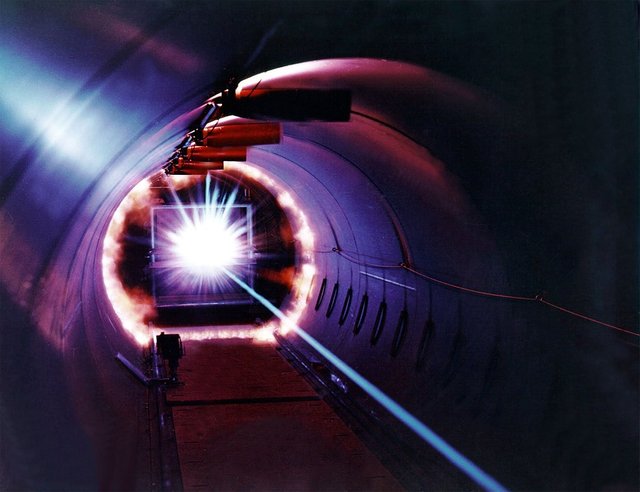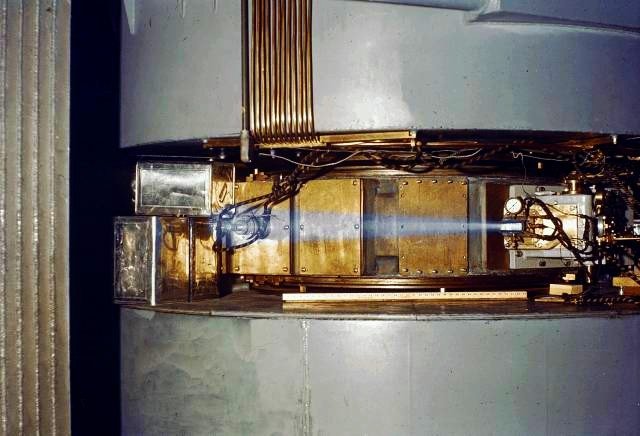The man who was struck by the power of a thousand suns - and survived

Hello fellow Steemians,
I would like to share an anecdote with you which I heard a while back in my courses that is actually quite factual:
A story of the only ever recorded particle accelerator injury in history and of defiance in the face of supposedly certain death. The tale of Russian Physicist Anatoli Bugorski who was struck in the head by a high-energy proton beam.
At some point one piece of the accelerator equipment malfunctioned and Burgorski proceeded to experimental hall to make some repairs. Contrary to common belief, in particular older systems are actually of quite modular construction and might have several beam exits points. This enables physical access to the accelerator tube and the beam trajectory without impeding its function and allows the accelerator to power a multitude of experiments simultaneously. In that way you may exchange collision targets or work on your detectors without deconstructing the entire ring.

*A beam exit point of an older cyclotron. The beam ionizes the sorrounding air causing an eerie blue glow.*
Unfortunately there seems to have been two other safety malfunctions/errors that day, namely a beam indicator bulb had burnt out and an automatic door locking mechanism had been deactivated for the previous experiment. Bugorski did not even realize that the proton beam was still active while he was working directly in its vicinity. And it so happened that his head crossed the path when a particle pulse was fired through the tube and he was struck by the high energy stream of matter moving right through his cranium close to lightspeed.
He would later report to have experienced the sensation of a flash "brighter than a thousand suns" but other than that no immediate consequences. So thourough was his diligence, that he even left everything in order, made an injury report, went home and did not consult a doctor until the next morning
At this point one side of his face had already swollen up beyond recognition and after explaining the incident he was quickly transferred to radiation specialists in Moscow's hospital number 6 - supposedly as much to help him as to study his expected demise. A tissue examination of the irradiated areas on his skull indicated a local dose of 200.000 - 300.000 Rads or 2000-3000 gray. In case of exposition of the entire body a dose of 5 gray is typically considered lethal, so the radiologist were fair to assume that Bugorski had received a total dose far in excess of the deadly one even though only his head was affected by the beam. Somewhat miraculously though, he did not display severe signs of radiation sickness and very slowly began to recover. It appears that while missing the most vital brain areas and cranial blood vessels, the beams very local nature was Bugorski's saving grace. The affected areas of his brain were clearly irradiated beyond repair, but the proton beam does not seem to have dispersed across his entire head or produced that many radioactive nuclear scattering products which could spread and cause secondary radiation damage.


Having been treated for about 1.5 years, he was finally released, although with the obligation to report to Moscow for regular examinations. Surprisingly the neurological long-term effects related to the incident were rather minimal, with Bugorski having lost hearing on one ear and displaying increased fatigue and a moderate epilepsy but no significant impairment of his mental capacity. He even returned to his workplace to complete his PhD and work as experimental coordinator in the very same institute later on!
Despite being one of the most famous subjects of Russian radiation medicine his story remained classified for a long time and he had to rely on help from his family, colleagues and charity to pay for his expensive medication outside of the clinical treatment. According to his own statement he had been interested to make himself available to western research institutes, but never could afford to move away from Protvino. To my knowledge, he still lives there up to this day with his wife Vera with whom he has a son, Peter.
I hope that this has been interesting to read and you have learned something new.
Have a nice day!
Sources: [Eco-Pravda (Russian)](https://web.archive.org/web/20120425115650/http://www.eco-pravda.ru/page.php?al=bugorsky_casus) [Wikipedia](https://en.wikipedia.org/wiki/Anatoli_Bugorski) Image sources: [1](https://pixabay.com/photo-11646/) (Pixabay by WikiImages) [2]( ) (Wikimedia Commons)
[3](
) (Wikimedia Commons)
[3]( ) (Eco-Pravda, presumably originally 6th Moscow Clinic )
[4](
) (Eco-Pravda, presumably originally 6th Moscow Clinic )
[4]( ) (Eco-Pravda, presumably originally 6th Moscow Clinic )
) (Eco-Pravda, presumably originally 6th Moscow Clinic )
i love science and keep it up
Hi, galotta! I just resteemed your post!
I am a new, simple to use and cheap resteeming bot.
If you want to know more about me, read my introduction post.
Good Luck!
Its a factual anecdote , thanks for steeming.
Argh, the html formatting is trolling me
Interesting story! I'd also like to do a followup on Marie Curie and just how exactly she died from radiation poisoning (Looking at the DNA damage mechanisms in detail that led to cancer)
Good idea
I've heard that Pierre and Marie Curie suffered surprisingly little radiation damage because they were working in a "lab" so run down that the wind going through it carried most of the radioactive dust away which they would have been exposed to otherwise